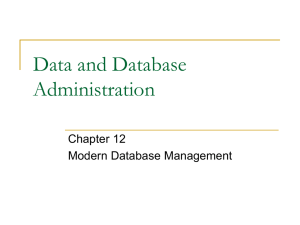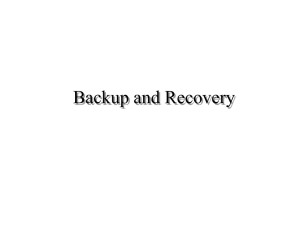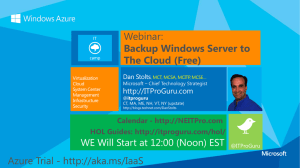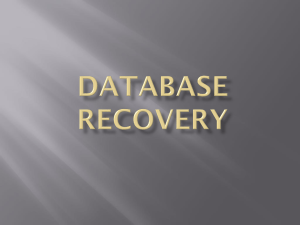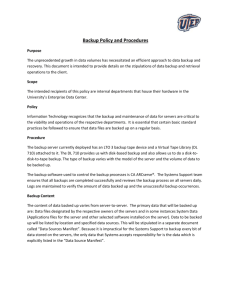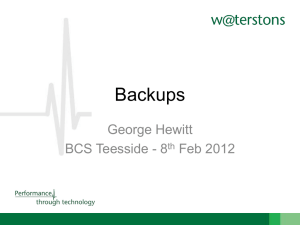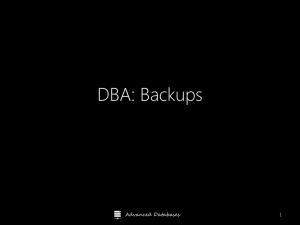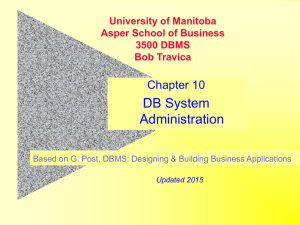Restoring and tuning a database
advertisement
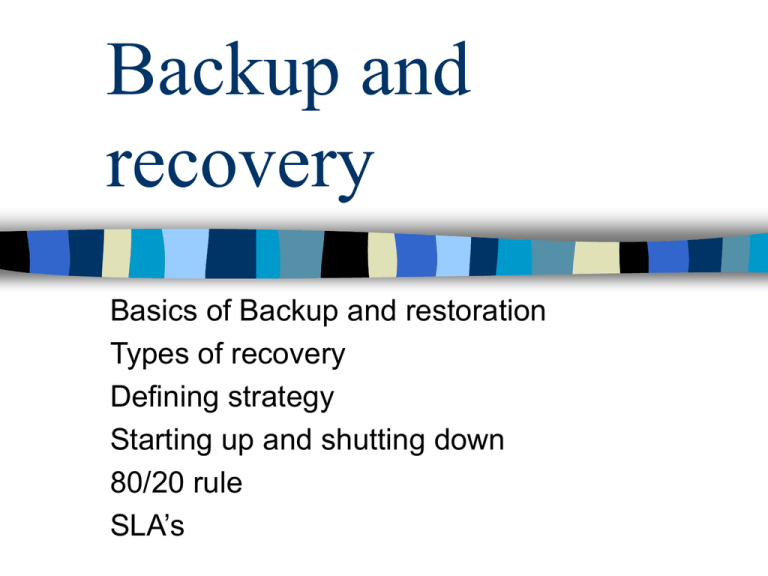
Backup and recovery Basics of Backup and restoration Types of recovery Defining strategy Starting up and shutting down 80/20 rule SLA’s Database backup restoration and recovery Physical files that make up db need to be backed up RMAN or user managed Copy files to correct location and let db recover itself Recovery process is starting the database and making it consistent with the backed up files Restoring and Recovering a Database Types of failure Non media or media/disk failure Media failures are most critical. To recover: – – – – – – Determine what files need recovery What type of media recovery is required Restore backups Apply offline redo logs (archive) Restore db to desired point Test process often! Defining backup and recovery strategy Has the following requirements / considerations – Amount of data that can be lost in event of failure – Length of time business can run without the DB – Can DB be offline to perform backup and how long for? – Types of resources available to perform backup/ recovery – Procedures for undoing changes to DB – Cost of buying and maintaining HW and additional backups V cost of replacing or recreating data Losing data in DB failure The amount of data that can be lost in a failure helps determine the backup and recovery strategy that is implemented Cold backups with no archive of redo logs – Updates since the last backup will be lost. The frequency of cold backup dictates the amount of data lost. Hot or cold backup with archiving of redo logs – No updates lost as long as all redo logs are kept since the last backup. Surviving without the DB in a DB failure The amount of time a business can survive without the DB is dependent on the type of business. Mean time to recover (MTTR) is obtained during testing of failure scenarios. If MTTR > business survival time then backup and recovery time should be re-addressed. Online backup There are two types of backup: offline and online. They are referred to as cold and hot. Offline (cold) are done when the database is closed. The downtime is related to database size and normally runs for several hours. Online (hot) are done when the DB is open but can affect performance. Archiving must be turned on for the hot backup. Undoing changes to DB There are 3 primary ways of undoing changes to the DB which do not involve backups Manual – Re executing code to rebuild data, dependent on the sophistication of the code releases and the configuration of the management control of the application (used in warehousing systems). Oracle log miner – querying the redo logs to recover the changed/dropped data. Flash back query – query undo segments to recover the changed/dropped data. Log miner Oracle utility allows you to generate the insert, delete and update statements from the change vectors in redo logs Logminer packages – Sys.dbms_logmnr_d.build – builds DD externally – Dbms_logmnr.add_logfile – access to desired redo log – Dbms_logmnr.start_logmnr – starts logminer session DD access To fully translate the contents of the redo logs, logminer requires access to data dictionary. Dbms_logmnr_d.build extracts DD information to a flat file or the redo logs in 9i More data can be found in oracle documentation e.g. Oracle9i Database Administrator's Guide – Chapter 9 Flash back Works of the undo data and lets the user see a read consistent view of the database in the past. It is easier than logminer. Only transactions committed can be viewed. User can specify the read only view based on system time or a system change number (SCN). Enables at session level. Max of 5 days back. Cont .. DBA must set the under retention interval long enough to be able to reconstruct the snapshot. Alter system set undo_retention = <seconds>; Max is 5 days Requires execute permission on DBMS_flashback Execute dbms_flashback.enable_at_time(sysdate1/24); Just remember to disable afterwards Setting archive mode Alter database archivelog (or noarchivelog) Sends files to location in init.ora file for log_archive_dest Default is off Select name, logmode from v$database; Cont .. 1. 2. 3. 4. Change or add init.ora parameter Log_archive_start = true Startup mount Alter database archivelog Alter database open Archive log list to check its logging Starting up a database Startup [option] Options available will determine state of database – Open – Mount – Nomount – Exclusive enables users to access db mounts DB for certain DBA activities starts BG processes but does not allow access permits only current instance to access the DB Start up errors ORA-12547: TNS: lost contact Or ORA-09352:windows 32-bit two task driver unable to spawn new oracle task These are common errors and mean that the oracle services in the control panel have not started. Shutdown Shutdown [option] Options – Normal default –waits for current sessions & transactions to end forces a check point and closes files – Transactional – waits for current transaction to finish before closing. – Immediate – forces check point and closes files – Abort – shuts down no save or close 80/20 rule Rule conceived by Vilfredo Pareto Minority of causes produce the majority of results Achieved by doing as much work as possible up front – in the design phase Set realistic expectations – Reasonable response times – Majority of efforts in tuning improves response time – Response time = work time + wait time Improving response time Improve either work time or wait time Improvement is driven by need to have transactions finish faster Tune component with the longest time – E.g.: if 20% of the time is spent with the CPU processing data and 80% due to delay in processing then improving CPU time will have less effect than reducing processing time Governed by an SLA (service level agreement) SLA’s How many transactions should be completed per min? How many users should be connected at peak times? How many concurrent transactions are expected at peak time? What times of the day are considered for online use only? What is that batch processing window? What is the expected response time for online processes? How much system resource should be available during peak time? – define margin of error
